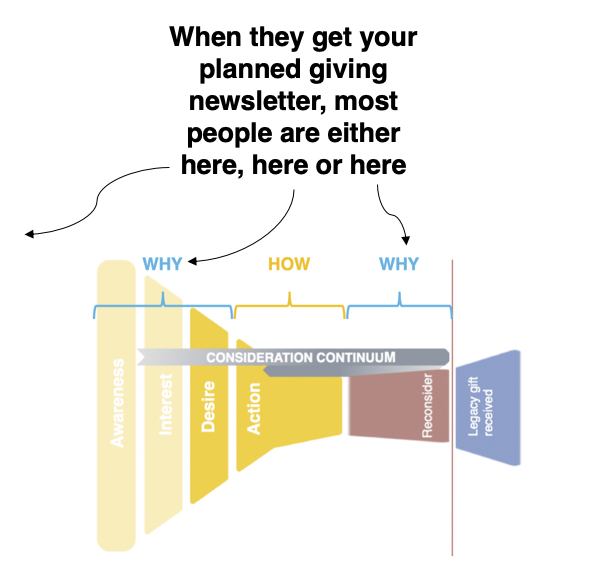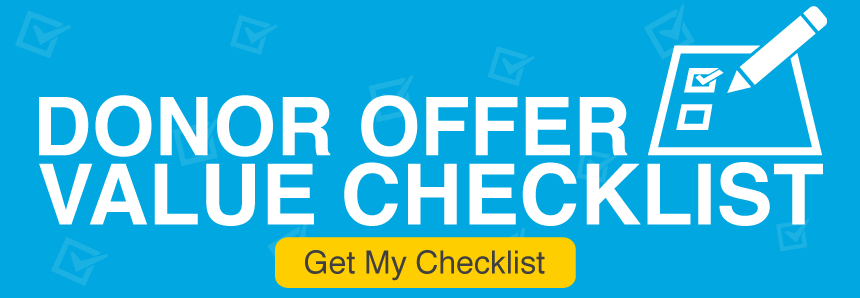We use cookies to ensure that we give you the best experience on our website. By continuing to use this site, you agree to our use of cookies in accordance with our Privacy Policy.
 Login
Login
Your Role
Challenges You Face
results
Learn
Resources
Company
Why hardly anyone reads your planned giving newsletter (and what you can do about it).


Confusing?
Too often planned giving newsletters are written by lawyers and the lawyers at nonprofits think they are just dandy. However, most of your supporters are not lawyers. If you want to learn what words work go here for our first report on the subject and here for the follow-up (both super-brief reports were developed with Dr. Russell James assistance).
Did they opt-in?
Your planned giving newsletter is designed to educate people about planned gifts, right? The problem is that most people are not ready for your education. Most of the people to whom you send your newsletter probably did not opt-in to receive it. Instead they were selected by you or your vendor and were sort of forced to accept it. Of course, that doesn’t mean they’ll read it.
And by the way, sending e-newsletters about planned giving to people who did not opt-in to receive them is SPAM! Just because the CAN-SPAM ACT excluded nonprofits from prosecution doesn’t mean that you should blast away. There are real people on the receiving end of your e-blasts. Invite them to opt-in before you SPAM ’em.
Don’t know the law or best practices? Go here now.
What decision-making stage are they in?
Here’s another reason. Let’s suppose you decided that 10,000 people should get your newsletter. How many do you think are actually in the decision-making stage of the consideration process for making a planned gift? Not many.
Most will either be entirely outside of the decision-making process or will be in the ‘why’ stage (asking themselves, “Why should I even consider such a gift?” Not, “How do I make one?”).

Trust?
Trust is the cornerstone in the foundation of all financial decisions. Absent trust, your attempts at persuading your supporters to make a planned gift will go nowhere.
You might disagree saying, “But they are donors. So, of course they trust us.”
Sure! For a $25 donation. But, perhaps, not so much for their legacy gift.
Trust is earned over time and builds more quickly when you show people you care about them. That requires sending the right messages at the right times.
So what should you do instead?
Determine where each supporter resides in the consideration process. The best way to do this is with a donor survey. Then be sure to use the information you’ve been given to split your list in two segments.
For those in the ‘why’ stage, deliver more content that shows others (like them) talking about how good they felt after making a planned gift. Tell their stories. Explain about how they found meaning in their lives through giving in this way. Use testimonials to help your readers see that others have felt good after going through the consideration process and making a decision. Emphasize permanence and how the supporter can live on in the minds of others after their lifetime. Use lots of photos and captions along with fairly large fonts and simple words. Write at about a 4th grade level. No legalese!
And for those in the ‘how’ stage, call them and write them with highly relevant, hyper-personalized messages that focus on their individual passions and interests (that were conveyed in their survey). This group will be very small compared with the number of people in the ‘why’ stage (see the graphic above and note that the funnel gets more narrow because less people will be nearly ready to take action at any given time).
This group deserves more! And since they are closest to making a decision, you should put a lot of effort into the communications you send them.
Give to them and make it super-relevant or their trust in you will wane.
Recommendations
>> 12 Questions that Lead to a Better Fundraising Story
LEAVE YOUR COMMENTS BELOW AND/OR SHARE THIS BLOG POST WITH YOUR PEERS!
Get smarter with the SmartIdeas blog
Subscribe to our blog today and get actionable fundraising ideas delivered straight to your inbox!

